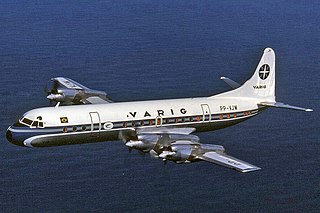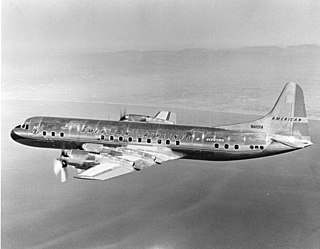SAM was a Colombian airline. With its main hub at El Dorado International Airport in Bogotá, SAM operated domestic and international routes and was a subsidiary of Avianca. In 2004, its headquarters were in the Avianca headquarters in Bogotá.

The Lockheed L-188 Electra is an American turboprop airliner built by Lockheed. First flown in 1957, it was the first large turboprop airliner built in the United States. Initial sales were good, but after two fatal crashes that led to expensive modifications to fix a design defect, no more were ordered. With its unique high power-to-weight ratio, huge propellers and very short wings, large Fowler flaps which significantly increased effective wing area when extended, and four-engined design, the airplane had airfield performance capabilities unmatched by many jet transport aircraft even today—particularly on short runways and high field elevations. Jet airliners soon supplanted turboprops for many purposes, and many Electras were modified as freighters. Some Electras are still being used in various roles into the 21st century. The airframe was also used as the basis for the Lockheed P-3 Orion maritime patrol aircraft.
This is a list of aviation-related events from 1960.

The Lockheed Model 14 Super Electra was an American civil passenger and cargo aircraft built by the Lockheed Aircraft Corporation during the late 1930s. An outgrowth of the earlier Model 10 Electra, the Model 14 was also developed into larger, more capable civil and military versions.

American Airlines Flight 320 was a scheduled flight between Chicago Midway International Airport and New York City's LaGuardia Airport. On February 3, 1959, the Lockheed L-188 Electra performing the flight crashed into the East River during its descent and approach to LaGuardia Airport, killing 65 of the 73 people on board. Weather conditions in the area were poor, which meant that the crew had to descend through dense clouds and fog. The aircraft flew lower than the pilots intended and it crashed into the icy river 4,900 feet (1,500 m) short of the runway at a speed of 140 knots. American Airlines had been flying the newly-developed Lockheed Electra in commercial service for only about two weeks before the accident.

The Trans Service Airlift Lockheed L-188 crash occurred on 18 December 1995 when a Lockheed L-188C Electra owned by Trans Service Airlift crashed near Jamba, Angola, killing 141 of the passengers and crew.

Garuda Indonesian Airways Flight 708 (GA708/GIA708) was a scheduled domestic passenger flight in Indonesia by Garuda Indonesian Airways from Jakarta to Manado, with stopovers in Surabaya and Makassar. On 16 February 1967, while operating the last segment of the flight from Makassar to Manado, the Lockheed L-188C Electra airliner crashed on landing at Mapanget Airport in Manado, killing 22 out of 84 passengers and eight crew on board.

Lufthansa Flight 502 was a scheduled flight from Hamburg, Germany to Buenos Aires, Argentina on 11 January 1959. The flight was being operated by a Lockheed L-1049G Super Constellation. On the leg between Senegal and Brazil the Super Constellation was on approach to Rio de Janeiro–Galeão International Airport when it crashed near Flecheiras Beach just short of the runway. All 29 passengers and seven of the ten crew were killed. It was the first fatal accident involving the current Lufthansa since it was formed in 1955.

American Flyers Airline Flight 280/D was a flight operated on a U.S. Military Air Command contract from Monterey Regional Airport in California to Columbus Airport in Georgia, via Ardmore Municipal Airport, Oklahoma. On April 22, 1966, while approaching Runway 8 at Ardmore, the aircraft overshot the runway and crashed into a hill, bursting into flames. Eighty-three of the 98 passengers and crew on board died as a result of the accident.

British Overseas Airways Corporation (BOAC) was the British state-owned airline created in 1939 by the merger of Imperial Airways and British Airways Ltd. It continued operating overseas services throughout World War II. After the passing of the Civil Aviation Act 1946, European and South American services passed to two further state-owned airlines, British European Airways (BEA) and British South American Airways (BSAA). BOAC absorbed BSAA in 1949, but BEA continued to operate British domestic and European routes for the next quarter century. The Civil Aviation Act 1971 merged BOAC and BEA, effective 31 March 1974, forming today's British Airways.

Reeve Aleutian Airways Flight 8 was an American domestic flight from Cold Bay, Alaska, to Seattle, Washington, on June 8, 1983. Shortly after takeoff, the Lockheed L-188 Electra of Reeve Aleutian Airways was travelling over the Pacific Ocean when one of the propellers broke away from its engine and struck the fuselage, damaging the flight controls. The pilots were able to make an emergency landing at Anchorage International Airport; none of the 15 passengers and crew on board were injured in the incident.

Air Manila Flight 702 was an unscheduled passenger flight from Naval Air Station Agana in Guam to Ninoy Aquino International Airport in Manila, carrying 33 passengers and 12 crew members; most of whom were personnel from the base. The Lockheed L-188A Electra attempted takeoff from runway 6L but crashed near a residential area; the crash was caused by retracting the flaps at an altitude too low to clear the terrain after the propeller of engine number three feathered. All 45 people on board and one person on the ground perished in the crash. The investigation concluded that the pilot should have followed company policy by aborting takeoff in the event of an engine failure before reaching VR (takeoff) speed.

KLM Flight 592, a KLM Douglas DC-6 was a scheduled passenger flight from Rome-Ciampino Airport (CIA/LIRA) to Frankfurt International Airport (FRA/EDDF). On Saturday 22 March 1952, Flight 592 crashed on final approaching to Frankfurt International around 10:45 AM Local time; 45 of the 47 people aboard the DC-6 were killed.

On 30 October 1974, a Lockheed L-188 Electra passenger plane taking off from Edmonton Airport crashed on Panarctic Oils Flight 416 shortly before landing at Rea Point Airfield on Melville Island in the Canadian Arctic. The plane hit the icy surface of the Byam Channel and went down. All 30 passengers and two of the four crew members were killed in the accident.












